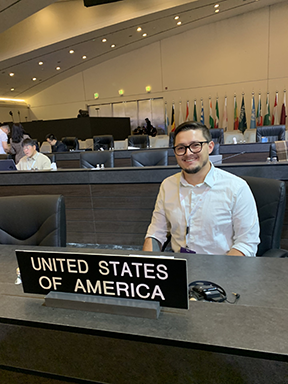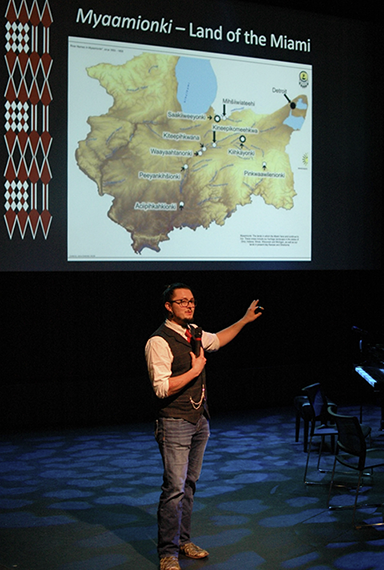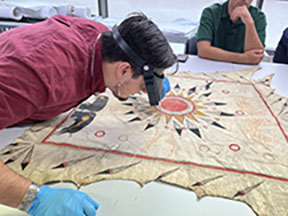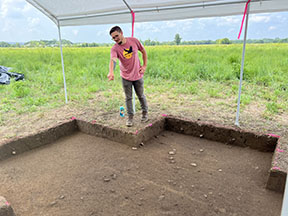
Logan York, Tribal Historic Preservation Officer, Miami Tribe of Oklahoma, Dayton, Ohio
Logan York is the Tribal Historic Preservation Officer for the Miami Tribe of Oklahoma and a citizen of the Tribe. Growing up in Kansas and Missouri, Mr. York regularly attended Tribal events, stomp dances, and language camps. He has a bachelor’s degree from Miami University (of Ohio) in Anthropology with minors in History and Archaeology. He went to work for the Tribe in April 2022 after previously working for Rebecca Hawkins, the consulting archaeologist for the Miami Tribe.
What led you to your field?
I have always been interested in history; it has always fascinated me. When taught correctly, it should fascinate everyone. It is the cumulation of all of humanity's most remarkable stories; that's all history is, right? It is the story of us. Stories have always come naturally to me; connecting with people with stories is easy. But I had not planned my whole life to be THPO. I went to college starting in 2016, and until the end of the second semester of my first year, I had not declared my major. I could not decide what to do, planning out your whole life at 18 is a daunting task. I tried out different courses from different majors, but I still couldn’t decide. One day I was called into Daryl Baldwin's office to discuss my options. I have known Daryl, and he has been a mentor since I was 9 years old, so it was always easy to talk to him. I told him I was always interested in history but loved being outside and using my hands. He asked if I had ever considered archaeology, which I had not. At that point in my life, I only knew that Indiana Jones did archaeology. (He does not do real archaeology!) Daryl recommended trying out a class, which I did. The only one I could get into was "The Archaeology of Power," a senior-level class on the archaeology of power dynamics. That was the most challenging class I ever took at Miami University, and it was my favorite class I ended up taking. It is why I declared my major, got into a field school, and worked for an archaeological firm out of Oklahoma for a few years. I loved it, the study of us in the past, our best stories, and our relationships with others. One day, towards my junior year, my firm asked me to monitor an archaeological site, and I happened to meet the previous THPO, Diane Hunter, there. We talked, and I told her of my interests and my degree. She asked if I would be interested in THPO work, to which I said yes. I had always wanted to work for the Tribe, but I never knew an avenue to pursue it. We talked the rest of that very hot summer day and parted ways. I did not see her again for three or so years.
Eventually, I graduated, moved back home, and then back to Ohio with my now-wife. I worked in construction, delivery, and even the medical field for a while before landing a job at a nonprofit archaeology firm out of Indiana. I worked there for about two years, overcoming my fear of public speaking and getting experience dealing with the public, and in archaeological studies. After all that time, I got a call from Julie Olds that they were opening a deputy THPO position and wanted me to apply based on my conversation with Diane. I did, and eventually got the position and apprenticed under Diane for a little under two years before she retired. I took over for her as THPO for the Miami Tribe. Every day is different now. Sometimes, I do archaeology, digging in the Illinois sun or studying painted hides in France. Still, I mostly work on my computer to help protect our archaeological sites from destruction and to educate the public in any way I can. I wouldn't trade how I got here for the world.
How does what you do relate to historic preservation?
That is all that I do, whether I am preserving physical archaeological sites through Section 106 consultation or educating the public, both Tribal citizens and the broader public, on Miami history, culture, language, and ecology. We preserve the past for our future here.

Why do you think historic preservation matters?
I think it matters for us because it helps preserve who we are. For Miami, there was a long period of cultural loss, starting with the diseases that swept through our homelands, through our wars with Europeans or their Native Allies in little proxy wars, to forced removal and boarding schools. Many of our cultural practices were forcibly taken, beaten, and killed out of us. It is through historic preservation that we have relearned what we can. From our language programs that have successfully gotten our language off the extinct languages list to lacrosse to hide painting, we are returning to preserve what we can of our past. It is not just our cultural past but our physical past. Preserving archaeology preserves my ancestors' physical past, which to us is often sacred and deserving of respect that has usually not been given. Through Section 106 of the National Historic Preservation Act, we can consult on projects that might have otherwise destroyed our archaeology, from mounds to cemeteries to houses, all of which I have managed to save through this consultation work. Physical manifestations of the past are powerful, not just for Miami people, but for every person. There's a reason that people feel such a pull to places like Stonehenge, the Great Wall of China, or the Hopewell Mound Groups. They are the physical places people connect to, which is really powerful. It connects you to the past that many people are finding increasingly further away with the new digital age. Still, culture and community are good for mental and physical health. These places are not meaningless piles of stone or earth but robust connectors to our past, and that is something that many people can feel the pull of, even if they don't quite know what they are feeling.
What courses do you recommend for students interested in this field?
I would recommend leaning into what interests you and you are good at. Me? I am good at stories, people, and history. I took mostly archaeology and anthropology classes, but someone who’s better at the business side of things or numbers should take math and business classes with the goal of aiming those learned skills to the benefit of historic preservation. We need everyone's help in this: we need people who can run business to make preservation viable; we need ecologists who know what plants to plant that won’t destroy historic buildings or archaeology; we need geologists, writers, architects, and chemists. We need people. What classes you take is less important than your goals with them. Yes, take anthropology classes, and history and archaeology, but don’t be afraid to take that chemistry class or that business class. Those are things the field needs too.
Do you have a favorite preservation project? What about it made it special?

My favorite project so far is our Minohsayaki Project, or our “Painted Hides” Project. It is a revitalization project for the Miami and Peoria communities to study four original Painted Hide robes and hopefully bring the art form back from dormancy. For us, historic preservation encompasses more than just protecting places and things; it also means learning from them and using that past, physical or otherwise, as scaffolding for our future.
Can you tell us what you are working on right now?
I work on thousands of projects. If we are talking Section 106, we are reviewing roughly 4,000 projects a year, though I recently learned that number will be going up quite a bit. For non-Section 106 projects, I work with hundreds of organizations, from Indigenous Cultural Trails at Indiana Dunes to new museum exhibits to school curriculum. If it has to do with Miami people, history, or culture, I probably have a hand in it somehow.
How do you think national historic preservation programs help your community?
Historic preservation is vital to community preservation; it protects our physical past with Section 106 work. Through this national program I can help preserve the archaeological or sacred sites in our traditional homelands, so that people can better connect with themselves and their people. That connection to place and connection to the past is missing in many people's lives, and historic preservation allows me to alleviate that as best I can for my people. Besides the physical preservation of our past, I am also in a position to better educate my people and the general public about Miami history and culture including material culture, whether that is directing weaving workshops or helping better direct hide painting we can help continue the revitalization of our art forms, which once again help better connect with one’s past and present. This is only possible for our office because of the national programs that help fund the personnel to get this done and get it done well.
Do you have any advice for novice preservationists?
Keep at it; it will get frustrating and challenging, and sometimes you will think to yourself “Why bother?” but you can't let setbacks get to you. You might be the person who preserves a 2,000-year-old
earthwork into its 3rd millennium or a historic building into its 300th year, rather than being torn down at 200. What we do is essential, but good to remember, historic preservation is not about the past but the future. It is not about preserving any archaeological site, building, or artifact. It's about being there to protect something that our future will enjoy, to provide future generations the same or better opportunities that we have here and now. Preserving what we can for the benefit of future generations who cannot protect it themselves.

The ACHP’s mission is “preserving America’s heritage;” can you give us an example of how your community is preserving its heritage?
The Miami Tribe of Oklahoma founded an entire department within itself to protect, preserve, and revitalize culture and heritage. That is what our Cultural Resource Office does every single day of the year. To protect, preserve, and revitalize our culture for our future generations, to give them the same or better as we have now and hopefully much better.
What are some of the unique challenges that come with your work as a THPO?
The most unique challenge that I have faced beyond the standard resistance to preserving historic resources rather than just destroying them for ease of future development is two-fold. One that we are here—most people don't think of Native Americans or their governments as really still here. To a lot, we are almost fictional, these mysterious people of the past that aren't still here if they ever were, but we are still here and were never a people of the past, just people with a past. They don't even think of trying to work with us because we aren't quite real in many people's heads. Even when people recognize that we are still here, they are terrified to try to work with us. I do mean that people are scared, generally for two reasons. Because they are worried about doing the wrong thing, they don't know how to reach out to Tribes, so it is better safe than sorry, and they don't reach out. Some I have found are scared to reach out because they are worried we will come in screaming and pointing fingers. That we are tough to work with because of all the bad things that've happened to us. However, I generally pride myself on being very friendly and understanding. Most partners will agree that we are very easy to work with, always looking at the long term and never trying to force changes too fast because we want all partnerships to be reciprocal and sustainable. The Miami Tribe will never come in yelling and screaming especially if you are trying to do right by us now. Yes, bad things have happened, but what matters now? It is what happens next. We don't want one significant gesture, which is the end of it; we want small, sustainable gestures over time that might build into something greater. One-and-done events accomplish little and cost a lot. We want to work with different groups all over our homelands and beyond and do that as easily and steadily as possible.
Can you tell us about your experience advocating for the Hopewell Ceremonial Earthworks' UNESCO designation?
My experience accumulated in the trip to Riyadh and studying as much as possible about these earthworks themselves to better defend them if need be. Being selected to be the Miami Delegate to Riyadh was surprising and humbling but much appreciated. It placed a lot of weight on my shoulders, because I was not just representing Miami people to a local library audience but to leaders from the entire world. Many were foreign ambassadors of different countries, and even a couple of the royal family of Saudi Arabia. It was a once-in-a-lifetime trip and quite a bit of studying to ensure I was ready. However, after 20 years of work, the presentation went so well that there was no deliberation. They presented, and the eight earthworks were added to the World Heritage List through a unanimous decision and a standing ovation. We got a standing ovation and a long line of handshakes from many of the ambassadors and delegates during the standing ovation. It was truly a humbling experience and exciting, and every one of us had tears in our eyes. Glenna Wallace said it was almost anti-climactic, all of the delegates there ready, all of that work after nearly 20 years to defend these amazing locations... and in less than five minutes it was done. All that studying further enhanced my interest in the earthworks and beyond. Not quite what I would call a waste! Overall, my experience advocating for the Hopewell Ceremonial Earthworks was an amazing once-in-a-lifetime opportunity that I would not trade for anything.
Read more Q&A stories about the Preservationists in Your Neighborhood!